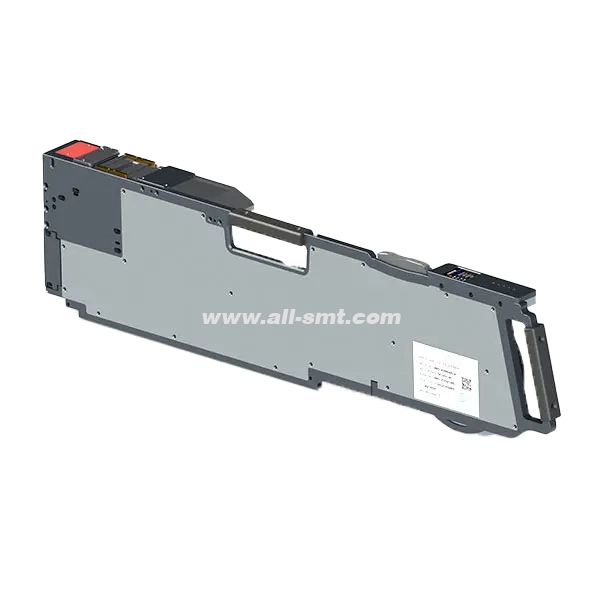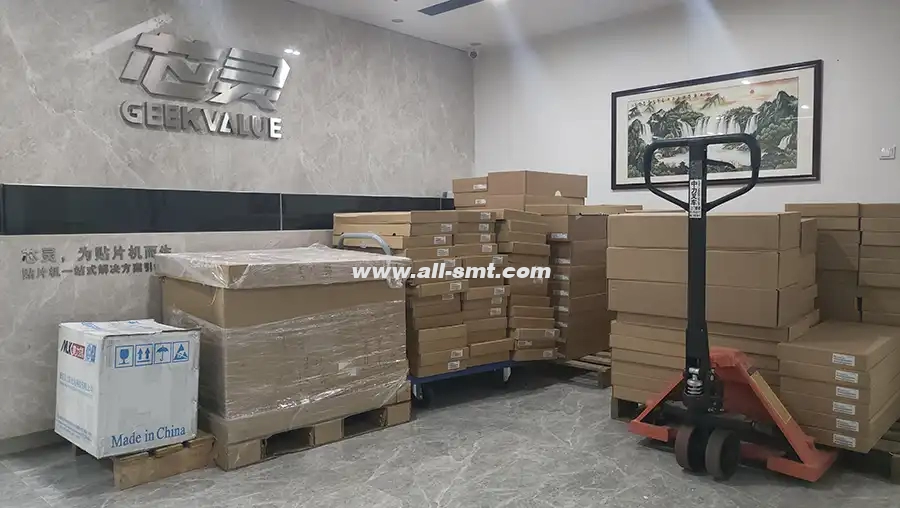An automatic Feeder SMT(also called pick‑and‑place feeder, PnP feeder, or simply Umnikeli we SMT) is a precision device that indexes carrier media—typically tape, tray, or stick/tube—to present electronic components at a repeatable pick point for the placement head of an SMT pick‑and‑place machine. Modern feeders are mechatronic systems with closed‑loop drives, peel‑back control for cover tape, anti‑backlash indexing, ESD‑safe paths, and, in intelligent variants, RFID/EEPROM that store part number, width, pitch, remaining quantity, and calibration offsets. By automating component presentation, feeders directly influence takt time, first‑pass yield, mis‑pick rate, and line OEE.

Compared with manual presentation, automatic SMT feeders maintain stable pocket exposure, consistent peel angle and force, precise pitch indexing (2/4/8/12/16/24/32 mm and above), and synchronized timing with nozzle motion. Choosing the right feeder requires matching component type (chips, ICs, odd‑form), carrier type and size (e.g., 8/12/16/24/32/44/56 mm tape widths; JEDEC tray; tube), machine family compatibility (ASM/SIPLACE, Fuji, Panasonic, Yamaha, JUKI, Hanwha‑Samsung, etc.), drive type (electric vs. pneumatic), and intelligent features (ID, lockout, kitting, traceability). Proper feeder selection and maintenance reduce jams, double‑picks, bounce‑outs, and downgraded speed due to conservative head profiles. In short, the feeder is the gateway between your reel and your placement head; getting it right is one of the fastest ways to stabilize output and cut rework on a modern SMT line.
What an Automatic SMT Feeder Does
Indexes the carrier medium by an exact pitch so the next component pocket is presented at the pick position.
Peels the cover tape at a controlled angle/force to expose the component pocket without ejecting parts.
Presents the component at a height and X‑Y position aligned with the machine’s pickup coordinates.
Signals ready/empty/jam status to the machine; intelligent variants also report part number, lot, remaining qty.
Protects components via ESD‑safe paths, controlled friction surfaces, and anti‑static materials.
Key performance links: Feeder accuracy → nozzle pick reliability → vision centering throughput → placement speed → FPY/OEE.
How Feeders Work (Indexing, Peel, Present)
1 Indexing Mechanism
Sprocket‑driven (tape): engages sprocket holes to step the tape exact pitch (2, 4, 8, 12, 16… mm).
Drive types: electric micro‑servo (quiet, precise, programmable) vs. pneumatic (robust, legacy).
Anti‑backlash gears and brake clutches maintain pocket stability at high speeds.
2 Peel‑Back Control
Peel angle typically kept between 165°–180° relative to tape plane; too steep → bounce‑outs, too shallow → stuck cover tape.
Peel force tuned to carrier/adhesive; intelligent feeders adapt peel force to speed to avoid micro‑vibrations.
3 Pick Presentation
Datum repeatability in X/Y/θ/Z matches machine expectations; high‑mix lines rely on feeder calibration stations to keep offsets within spec.
Pocket support prevents thin chips from flipping when nozzle contacts.
Vacuum sync: indexing pauses and nozzle motion are synchronized to minimize pick‑on‑move errors.
SMT Feeder Types and Use Cases
1 Tape Feeders (Most Common)
Widths: 8, 12, 16, 24, 32, 44, 56+ mm; dual‑track 8 mm variants double lane density.
Pitches: common pitches 2/4/8/12/16/24/32 mm; select pitch to match pocket spacing.
Amacandelo: chips (0201/0402/0603/0805), small ICs, connectors, power inductors (wider tapes).
IiPros: fastest changeover, best for high‑speed chips; Ububi: cover tape waste, relies on good splicing.
2 Tray/Matrix Feeders (JEDEC)
Used for QFP, BGA, CSP, and tall parts sensitive to tape handling.
Shuttle or elevator systems present trays to pick height; slower than tape but gentler.
3 Stick/Tube Feeders
For axial/odd small ICs still supplied in tubes.
Vibratory advance; sensitive to orientationkwayestatic.
4 Bulk/Vibratory Bowl Feeders
For specialty odd‑forms and mechanicals; integrate with vision to locate parts in 2D/3D before pick.
5 Label/Media Feeders (Optional)
Feed labels, film spacers, pads; requires unique peel geometry and image verification.

Brand Ecosystem & Compatibility Basics
Always match machine family and feeder family; cross‑brand adapters exist but can limit speed/IO.
I-ASM / SIPLACE families (S, X, SX, TX, D‑Series): wide tape and intelligent feeder ecosystems with trolley kitting.
Fuji (NXT, AIM, CP, XP): electric feeders, strong ID integration; NXT smart feeders dominate in high‑mix.
Panasonic (CM, NPM, AM): robust electric feeders and cart‑based logistics.
Yamaha (YS, YSM, YSF): known for dual‑track 8 mm; CL/SS/ZS series—confirm exact generation.
IJUKI (KE, FX, RS‑1/RS‑1R): intelligent feeders with optimization via IFS/NM systems.
Hanwha‑Samsung (SM, Decan): electric feeders with comprehensive 8–56 mm coverage.
Checklist: machine model → feeder series → width/pitch → connector/IO → mechanical latch/rail → software ID.
Selecting the Right Feeder (Step‑by‑Step)
Map components to carrier: chip vs. IC vs. odd‑form; tape width & pitch; reel diameter (7"/13"/15").
Confirm machine family: exact model & year; feeder series ID.
Choose drive & intelligence: electric + RFID for high‑mix; pneumatic ok for legacy speed ranges.
Throughput target: match feeder response time to head’s pick window; avoid feeders slower than nozzle cadence.
ESD & materials: ensure conductive paths; avoid particle‑shedding liners.
Serviceability: access to peel path, sprocket, springs, idlers; spare kits availability.
Lifecycle: firmware upgradability (intelligent feeders), calibration tooling support.
Cost‑of‑ownership: MTBF, jam rate, spares price, resale value, vendor support.
Ngengcebiso: On chip‑dense lines, prioritize dual‑track 8 mm to increase slot density and shrink head travel.
Feeder Speed, Takt Time & Capacity Planning
1 Simple Takt Model
Line takt ≈ max(placement head cycle time, slowest feeder service time, vision bottleneck).
A feeder with index + settle slower than the head’s pick cycle becomes the bottleneck.
2 Slot Density and Head Travel
More 8 mm slots near the head’s optimal zone → less XY travel → faster CPH.
Avoid placing slow wide‑tape feeders in the center zone if chips dominate.
3 Changeover & Kitting
Cart/trolley with preloaded smart feeders → near‑zero offline changeover; traceability preserved via RFID.
For prototype/high‑mix, invest in extra feeders to keep top‑20 BOM items permanently loaded.
Rule‑of‑thumb table:
| Feeder Choice | Impact on Speed | Utshintsho | Risk |
|---|---|---|---|
| Dual‑track 8 mm | ↑ slot density, ↑ CPH | Phakathi | Needs good splicing discipline |
| Electric (smart) | ↑ precise index | Phantsi | Higher initial cost |
| Pneumatic legacy | Adequate | Medium–High | Less data/ID, more wear |
| Tray shuttle | Lower speed | Phakathi | Gentler handling for BGAs |
Setup & Calibration Essentials
Feeder calibration station: verify pickup coordinates (X/Y/θ/Z) and pitch; store offsets in ID memory.
Peel path tuning: set peel angle/force for each tape supplier; record as line recipe.
Pocket support: add under‑pocket shims for ultra‑small chips (0201/01005) to avoid bounce.
Vision teach: confirm component center and height; re‑teach after tape supplier change.
Torque & tension: tune take‑up reel drag to avoid back‑tension jams.
Calibration cadence: new/serviced feeder → before 1st run; repeat every 3–6 months or after incidents.
Best Practices for Splicing & Replenishment
Use alignment jigs for 8 mm; align sprocket holes to avoid one‑tooth error.
Choose splice tape/clip that matches tape material (paper vs. embossed).
Stagger splices across lanes to prevent synchronized jams.
Log splice position in MES; avoid splicing within vision window if possible.
After splice, index slow ×3 for safety, then return to normal speed.
Kitting tip: Pre‑label reels with internal part number + feeder width/pitch to eliminate last‑minute guesswork.
Quality, Defects & RCA Playbook
Symptoms → Likely Causes → Countermeasures
Mis‑pick / no‑pick → wrong Z height, pocket too deep, peel force too high → recalibrate Z/pocket support, tune peel.
Double‑pick → pocket overfill, adhesive residue, vacuum too high → clean pocket path, adjust vacuum timing.
Bounce‑out → peel too abrupt, angle too steep → reduce peel angle/force; add pocket support.
Tape jam → splice misalignment, worn sprocket, debris → inspect sprocket tooth wear, replace idlers, retrain splicing.
Cover tape tear → aged adhesive, low temp → precondition reels; warm to room temp; change supplier setting.
Component flip → nozzle contact off‑center, high acceleration → re‑teach pickup; smooth accel profile.
ESD damage → poor path resistance → verify ESD chain, ionization, mats, wrist/ground checks.
Metrics to watch: mis‑pick rate (%), splice MTBF (reels/splice), feeder MTBF (hrs), index error (µm), cover‑peel force (N).
Maintenance, Cleaning & Service Intervals
Yonke imihla: blow off debris (ionized air), inspect peel path, verify take‑up tension.
Weekly: clean sprocket teeth, check spring/gear wear, verify lane alignments.
Monthly: lubrication per OEM spec (where applicable), replace worn idlers, validate ESD continuity.
Incident‑based: after jam/impact, run full calibration and pocket‑height test.
Spare kit: sprocket set, springs, peel roller, idlers, covers, encoder (electric), ESD pads, screws.
New vs. Pre‑Owned Feeders: ROI & Risk Control
Entsha: warranty, latest firmware, verified ID; higher CapEx but lower ramp risk.
Pre‑Owned: strong savings and fast availability; require accredited testing (index accuracy, peel, ESD, memory).
Hybrid: buy new for critical 0201/01005 lanes; use serviced pre‑owned for wider tapes and non‑critical ICs.
Acceptance test template:
Visual/mechanical (latch, rails, connectors)
Index accuracy @ rated speed
Peel force range & stability
ESD path (Ω)
Memory read/write cycles (intelligent)
Trial run with your actual reels and nozzles
Intelligent Feeder Workflow (ID, WIP, Traceability)
Feeder ID (RFID/EEPROM) ties P/N to feeder; line software prevents wrong‑part loading (POKA‑YOKE).
Remaining quantity auto‑calculated → kitting knows when to stage next reel.
WIP tracking: feeder ID + reel lot → MES/ERP for traceability and RMA defense.
Analytics: jam heatmap by feeder ID, operator, reel supplier.
ESD, Safety & Compliance
Izinto eziphathekayo: conductive/antistatic plastics and coated metals; verify surface resistivity.
Grounding: check continuity from feeder frame → machine → earth; ionizers at peel/pick zone.
Operator safety: guarded peel reels, pinch‑point awareness, lockout when servicing.
Environment: maintain humidity per component MSL/ESD guidelines.
Troubleshooting Guide (Symptoms → Probable Cause → Fix)
| Symptom | Probable Cause | Quick Fix |
|---|---|---|
| Intermittent no‑pick | Pitch slip, peel surge | Re‑teach pitch; stabilize peel force; clean peel roller |
| Frequent jams at splice | Misaligned holes | Use jig; verify hole alignment; re‑splice |
| Cover tape re‑adhesion | Low temperature or adhesive variant | Warm reels; adjust peel angle; change supplier setting |
| Double‑pick on 0402 | Vacuum profile too high; pocket shallow | Reduce vacuum impulse; add support shim |
| Vision rejects after pick | Component shifted during lift | Slow initial Z‑lift; verify nozzle center and acceleration |
| Feeder not recognized | Connector/ID fault | Inspect pins; test RFID/EEPROM; reseat; firmware check |
Procurement Checklist & Supplier Questions
Exact imodeli yomatshinikwayesoftware version?
Required feeder series (ID, connector, latch) and width/pitch?
Drive type preference (electric/pneumatic) and noise limits?
Need dual‑track 8 mm lanes?
Calibration station and spare kits included?
Acceptance test before shipment? Video or on‑line witness?
Lead timekwayeRMA policy?
For pre‑owned: test report (index, peel, ESD, memory), cosmetic grade, hours in use.
Glossary (SMT Feeder Terms)
Pitch: center‑to‑center distance between pockets in carrier tape.
Dual‑track 8 mm: feeder with two 8 mm lanes in one slot to increase density.
Peel force/angle: parameters controlling cover tape removal.
Intelligent feeder: stores ID and parameters for traceability and POKA‑YOKE.
Splicing: joining new reel leader to the running tape to avoid stoppage.
Pocket support: surface that prevents part movement during pick.
CPH: components per hour; practical speed metric for PnP.

Automatic Feeder Conclusion & Next Steps
The feeder determines how cleanly and predictably components reach the nozzle. Match carrier → feeder → machine; invest in calibration and peel tuning; standardize splicing; and log the right metrics. For cost‑effective scaling, pair intelligent electric feeders on critical chip lanes with serviced pre‑owned units on wide‑tape/low‑risk lanes.
Implementation quick‑wins:
Audit lane assignments and move dual‑track 8 mm near the head’s sweet spot.
Introduce a splicing jig and record splice MTBF.
Calibrate peel force per tape supplier and lock in as a line setting.
Create a feeder maintenance calendar (daily/weekly/monthly) tied to OEE.
FAQ
-
What’s the difference between electric and pneumatic feeders?
Electric feeders offer programmable, repeatable indexing and quieter operation—ideal for small chips and high‑mix. Pneumatic feeders are durable and cost‑effective for legacy platforms but lack granular control and data.
-
Can one feeder fit multiple tape widths?
No. Feeders are width‑specific (8/12/16/24/32/44/56 mm). Some brands support dual‑track 8 mm but you still need dedicated hardware.
-
Do I need intelligent feeders?
If you run high‑mix or require traceability, yes. ID memory prevents wrong‑part loading, speeds kitting, and supports analytics.
-
How often should feeders be calibrated?
New/serviced units before first use, then every 3–6 months, or after jams/impacts/major recipe changes.




